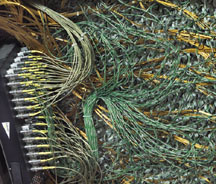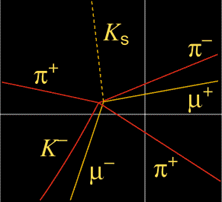
Located at SLAC, PEP II is an "asymmetric" collider,
one in which the two colliding beams of particles are not of equal energies.
Because PEP IIís mission is to produce copious quantities of B mesons, sub-atomic
particles containing a "bottom" quark (the fifth of the six quarks believed
to be the fundamental constituents of matter), with factory-like reliability,
it has been popularly dubbed the "B factory."

![]()
Measuring and comparing the times over which B mesons and B-bar mesons (the B mesonís antimatter counterpart) decay into various final states offer scientists their best opportunity to study differences between matter and antimatter, particularly the phenomenon known as CP violation (charge-conjugation/parity). This phenomenon is widely suspected to be the reason why, so far as we know, the universe today is essentially absent of any antimatter save for the tiny bits artificially created in colliders.
According to the Big Bang theory of creation and the Standard Model of physics, the energy released by the vast explosion that started the universe should have congealed into equal or symmetric amounts of matter and antimatter that would then have quickly annihilated one another in bursts of energy.
We are living proof, however, that such was not the case.
From out of the Big Bang there must have emerged a preference for matter—it need only have been one excess particle of matter out of every billion matter-antimatter pairs.
No one knows to what extent CP violation was responsible for the original imbalance between matter and antimatter. In the universe today, CP violation is an extremely rare event and only minute effects have been observed in the decay of a cousin of the B mesons called the K meson or kaon. Scientists believe that much larger effects could be observed in the decay of B mesons but until the advent of the B factory at SLAC, and a similar facility in Japan called the KEKB, lacked the means of doing so.
The concept behind the two B factories
came from Berkeley Lab Deputy Director Pier Oddone, back in 1987, while
he was director of the Labís Physics Division. Oddone proposed that the
best way to produce and study B particles would be to construct an asymmetric
collider that could create a separation in space between the decay products
of individual B and B-bar mesons.

![]()
A collision between an electron and a positron yields a particle known as the upsilon 4S which immediately decays into a B meson and a B-bar meson. These B particles in turn decay into a host of other charged and neutral particles whose detection can provide a wealth of information. However, in a collider where the energies of the two beams are equal, the newly created B particles remain nearly stationary, making it all but impossible to study the time evolution of their decay products. Under Oddoneís asymmetric scheme, when the two beams collide, the B particles are carried downstream in the direction of the higher energy beam. This forward motion enables the decay products to separate, allowing scientists to observe the distances between their points of decay.
"We developed the concept of the asymmetric B factory by a combination of inspiration and perspiration," Oddone has said. "The initial idea was more like a flash . . . gee, if we could collide asymmetrically then . . . But colliding asymmetrically with a high rate of events is tough."
The B factory meets this tough challenge with the High Energy Ring (HER), which stores electrons at an energy of 9 GeV (billion electron volts), and the Low Energy Ring (LER), which stores positrons at 3.1 GeV. The rings, both of which measure nearly 2.2 kilometers in circumference (1.36 miles), are stacked together in the same tunnel with the LER positioned immediately above the HER. Berkeley Lab had primary responsibility for the design, construction, and commissioning of the LER, one of the most technically demanding storage rings ever created.
Berkeley Lab researchers also
played a key role in the design and construction of the B factoryís detector,
the $120 million, 1,200 ton colossus known as "BaBar."† (The KEKB also has
one detector called "Belle.")† Because the most powerful B decays relevant
to CP violation are rare, tens of millions of B/B-bar pairs must be produced
in order for scientists to find interesting physics. This requires unprecedented
"luminosity"—a measurement of the rate of particle collisions. The
B factoryís design calls for a luminosity of 3 x 1033 (3 followed by 33
zeros) collisions per square centimeter per second, which is at least 10
times better than the highest luminosity achieved with the best machines
in the world today.
PIER
ODDONE
![]()

It
was at a 1987 workshop hosted by UCLA that Piermaria Oddone,
Peruvian-born, MIT- and Princeton-educated and then the
head of Berkeley Labís Physics Division, first proposed
the construction of an asymmetric collider of electrons
and positrons as the best way to look for asymmetry between
matter and antimatter. His proposal represented a radical
break with tradition, in that electron-positron colliders
had always been designed to smash together beams of equal
energies. But skeptics were eventually won over. There
are now two "B factory" colliders based on Oddoneís asymmetric
scheme.
![]()
In its first year of operation, the B factory produced approximately 10 million B/B-bar pairs inside BaBar, a sample comparable to what has been recorded on all previous electron-positron colliders. Of these pairs, 120 decayed into the "cleanest channels" that can be studied for signs of CP violation.
"The experiment is working just as predicted," says Oddone. "A precise measurement of CP violation in B meson decay should be achieved in the next year or two."
What is most significant at this time is that the B factory and BaBar are performing at near design specifications. It was expected that these machines with their state-of-the-art technological innovations would require several years of operation before being able to perform at their full potential.
Said an exuberant SLAC director Jonathon Dorfan, "The entire B factory, both collider and detector, has come on line smoothly and in record time, to the great credit of the machine builders and the delight of the hundreds of BABAR scientists now trying to cope with the flood of data!" — Lynn Yarris
|
|||